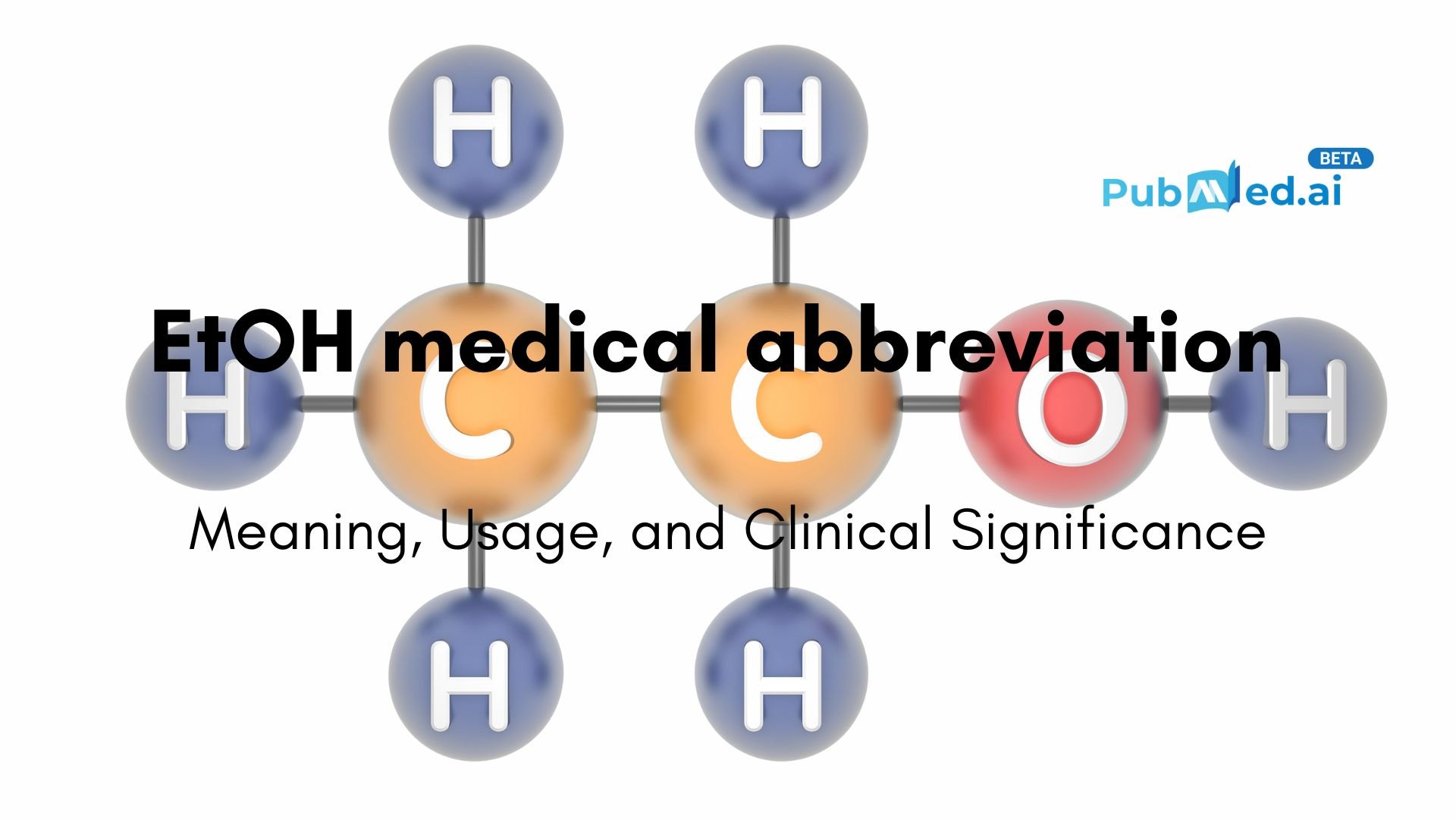
EtOH Medical Abbreviation: Everything You Need to Know About Ethanol in Clinical Contexts

EtOH is the medical abbreviation for ethanol, the type of alcohol found in beverages. Clinicians use this shorthand in patient charts, electronic medical records (EMRs), and clinical documentation to indicate alcohol consumption, exposure, or related health issues. It’s concise, widely recognized in medical settings, and often appears alongside qualifiers like nil EtOH, social EtOH, or hx EtOH to describe the patient’s alcohol history.
You know what? While it seems simple, understanding EtOH is crucial—not just as a chemical, but as a marker for potential health risks, from liver disease to withdrawal complications (CDC: Alcohol and Public Health).
Check the answer from PubMed.ai
What Is EtOH?
At its core, EtOH is the chemical abbreviation for ethanol, the same molecule found in alcoholic beverages (PubChem: Ethanol). You might recognize it from chemistry class: "Et" for ethyl, "OH" for the hydroxyl group. But in the medical world, EtOH carries extra weight—it’s shorthand in charts, EMRs (PubMed.ai search: EtOH in clinical notes), and clinical discussions to indicate alcohol consumption or exposure.
Clinicians love shorthand. It’s efficient, saves time, and reduces repetitive typing—but it can also create misunderstandings, especially for students, new nurses, or interdisciplinary teams.
EtOH in Nursing and Medical Notes
In nursing notes, you might see entries like:
- “S/P fall; EtOH use suspected”
- “Hx EtOH abuse; monitoring liver function”
Understanding EtOH in this context helps anticipate clinical issues—like liver enzyme elevations, withdrawal risk, or medication interactions (Mayo Clinic: Alcohol-related liver disease).
EtOH Abuse
EtOH abuse is defined as continued consumption despite harmful physical, social, or psychological consequences (NIH: Alcohol Use Disorder).
- Symptoms: slurred speech, impaired coordination, withdrawal tremors.
- Diagnosis: patient history, lab values (liver enzymes, CDT testing), screening tools like CAGE or AUDIT.
- Long-term effects: cirrhosis, pancreatitis, cardiovascular complications, cognitive deficits.
EtOH Levels and Lab Values
EtOH levels in blood, serum, or breath can help quantify exposure (PubMed.ai search: Ethanol blood levels):
- 0.01–0.05 g/dL: mild effects; socially drinkers may feel relaxed
- 0.08 g/dL: legally intoxicated in many countries; impaired judgment
- 0.3–0.4 g/dL: potentially life-threatening; risk of respiratory depression
Clinicians monitor BUN, creatinine, liver enzymes, electrolytes in chronic EtOH exposure. Elevated GGT or MCV can hint at long-term alcohol use (Lab Tests Online: GGT).
Some studies suggest subtle cognitive changes even at low levels of chronic EtOH exposure—memory lapses, slight attention deficits—making EtOH more than shorthand; it’s a marker for physiological stress (PubMed.ai search: Ethanol cognitive effects).
Special Contexts: EtOH in Pregnancy and Mental Health
- Pregnancy: Any EtOH exposure can risk fetal alcohol spectrum disorders (CDC: FASD).
- Mental health: EtOH abuse frequently co-occurs with depression, anxiety, or bipolar disorder (PubMed.ai search: EtOH mental health).
Clinicians sometimes add qualifiers in notes like “EtOH abuse with depressive symptoms”—a flag for integrated care.
How Clinicians Document EtOH
Ever notice variations like nil EtOH, social EtOH, ex EtOH, hx EtOH?
- Nil EtOH: patient reports no alcohol consumption
- Social EtOH: occasional, non-problematic drinking
- Ex EtOH: formerly consumed, now abstinent
- Hx EtOH: past history of alcohol use
These qualifiers communicate nuanced patient information efficiently. A casual reader might gloss over “nil EtOH,” but for a prescribing physician, it can influence medication choices, anesthesia planning, or risk assessment.
EtOH in Cardiology and Liver Disease
- Cardiology: Heavy alcohol can cause arrhythmias (“holiday heart syndrome”), cardiomyopathy, hypertension (Mayo Clinic: Alcohol and Heart)
- Hepatology: EtOH impacts AST, ALT, bilirubin (PubMed.ai search: EtOH liver enzymes)
You might see shorthand like EtOH cirrhosis in notes—a quick flag for liver condition.
Withdrawal and Detox
EtOH withdrawal can range from mild anxiety and tremors to life-threatening delirium tremens (NIH: Alcohol Withdrawal). Proper documentation of EtOH directly influences withdrawal management, dosing of medications like benzodiazepines, and patient safety.
EtOH in Research: Why It Matters
For biomedical researchers, EtOH isn’t just shorthand; it’s data. Studies categorize participants based on EtOH consumption levels:
- Non-drinkers
- Light/moderate drinkers
- Heavy drinkers / EtOH abuse
Accurate documentation allows better correlation with disease outcomes, drug metabolism studies, and cognitive research (PubMed.ai search: EtOH clinical research).
Connecting the Dots: Why EtOH Matters in Daily Practice
EtOH intersects almost every aspect of patient care. From diagnosis to treatment planning, risk assessment to research, this tiny abbreviation carries weight. Understanding EtOH helps clinicians see behavioral patterns and biochemical consequences, not just numbers.
FAQs About EtOH Medical Abbreviation
1. What does EtOH mean in a medical chart?
EtOH is shorthand for ethanol, used to document alcohol use or exposure.
2. How is EtOH abuse diagnosed?
Through patient history, lab tests (liver enzymes, EtOH levels), and screening tools like AUDIT or CAGE.
3. What does nil EtOH indicate?
The patient reports no alcohol consumption; important for medication planning and risk assessment.
4. Why is EtOH documentation important in pregnancy?
Even minimal exposure can cause fetal alcohol spectrum disorders. Proper documentation ensures counseling and care (CDC: FASD).
5. How does EtOH affect long-term health?
Chronic exposure can lead to liver disease, cardiomyopathy, neurological changes, and mental health comorbidities (PubMed.ai search: EtOH long-term effects).

Have a question about medical research, clinical practice, or evidence-based treatment? Access authoritative, real-time insights: PubMed.ai is an AI-Powered Medical Research Assistant.
Your AI Medical Update
Subscribe to our free Newsletter